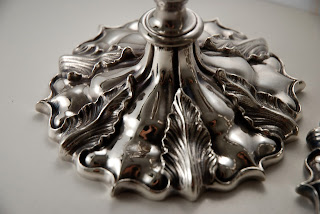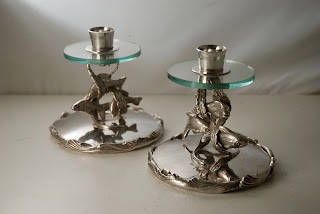Investing in Silver: Advice for the Modern Collector.
There's no denying, financially speaking we live in uncertain times. The Credit Crunch has had many far reaching effects, but for most people with a little expendable cash, one thing holds true: putting your money in the bank yields little return. So then, what to do with it?
There are other investments to make, of course- stocks and shares, futures, commodities, fine wines, art and of course antiques.
 |
| A Fine Silver investment Bar. |
My area of expertise is, of course antiques. Specifically silver. We have seen the bullion price of silver and gold skyrocket since the Crunch, and this has certainly impacted on the price of silver antiques in many examples. But what does all this mean?
A little financial advice. What would I recommend? Well, I'm no financial advisor, but something that any investor should understand is that investment is always subject to risk. Many bright sparks will tell you that X or Y is a sure bet, and they are sometimes proved to be right. But the general rule is that there is no such thing as a sure bet. Investing isn't about sure bets, it's about risk management.
 |
| Sterling Silver Goblets |
Rule one of antique silver investment: Unless the value of sterling silver jumps again, antique silver is usually not a good short term investment. If you're thinking of putting your money in to something you will want to liquidate in the next five years, don't choose antique silver unless you wish to speculate on the price of silver.
The other important point to note of course, is that any investment that has the potential for high short term returns is likely to be high risk. Things which soar in price over a short period also crash. Making money isn't that easy, or everyone would be doing it!
There are, of course, exceptions to the rule. There always are. The work, and especially enamel work, of Gerald Benney has jumped up in value over the last five years. So has Chinese silver. Domestic Georgian silver, in general, has dropped. Large, heavy pieces of silver, which are usually valued in proportion to the weight, have increased in value. Four piece Victorian tea sets are twice the value they were five years ago.
If you're clever enough to identify these trends and jump on the bandwagon then good luck to you. You might need it though!
Rule two of antique silver investment: Buy things you like and will enjoy, and prepare to pass them down to the next generation.
 |
| A Georgian silver Wine Coaster |
But as they grow in age fine pieces will accrue in value, increase in rarity and become more desirable. This is where the smart money is. Buy the best you can afford, and allow it to become rarer and more important while you own it.
There is also the important issue of death duties. In the United Kingdom, antiques are not subject to death duties when you pass them down (provided they were not purchased within seven years of the time of death). Therefore they are an excellent way to ensure a financial legacy.
The real joy of antique silver though, is not simply financial. I always advise customers to buy what they love, and will enjoy owning, and even using! Investment is an important consideration when buying antiques, and the idea of handing down a legacy of fine and valuable objects is an attractive one. However, what could be better than putting your money in to something which is a joy to own and use, enriches your life, and at the same time a healthy way to protect your money?!
James Baldwin is owner of James Baldwin Antiques: Antique Silver, Georg Jensen and Old Sheffield Plate
 |
| A Sterling Silver Chess Set weighing just under 4 kilos |















